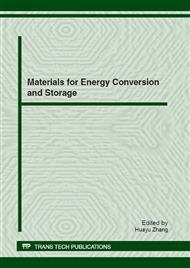p.83
p.87
p.92
p.96
p.100
p.104
p.108
p.113
p.118
Production of Bio-Fuels by Enzyme-Catalyzed Hydrolysis of Cellulose
Abstract:
Converting biomass into fuel is becoming increasingly important owing to the desirability of finding substitutes for fossil fuels and to the need to address the problem of global warming. Cellulose, one of the main constituents of biomass, is the most abundant bio-renewable material on the planet. Considerable effort has been devoted to the hydrolysis of cellulose in order to convert it into fuel. In this paper, both two-dimensional electrode electrochemical degradation of cellulose and the use of biological degradation of cellulose were investigated, which provides a detailed study of cellulose activity and stability in various ionic liquids. In the two-dimensional electrode reaction system, after 5 hours at the voltage of 8 V under the conditions of electrolysis, the degradation of cellulose reached 43.7%, BOD5/COD also significantly improved with biological treatment to the combination of electrochemical techniques. As the result, HEMA is a promising, novel, green medium for performing cellulose hydrolysis reactions to convert biomass into bio-fuels.
Info:
Periodical:
Pages:
100-103
Citation:
Online since:
July 2012
Authors:
Keywords:
Price:
Сopyright:
© 2012 Trans Tech Publications Ltd. All Rights Reserved
Share:
Citation:


